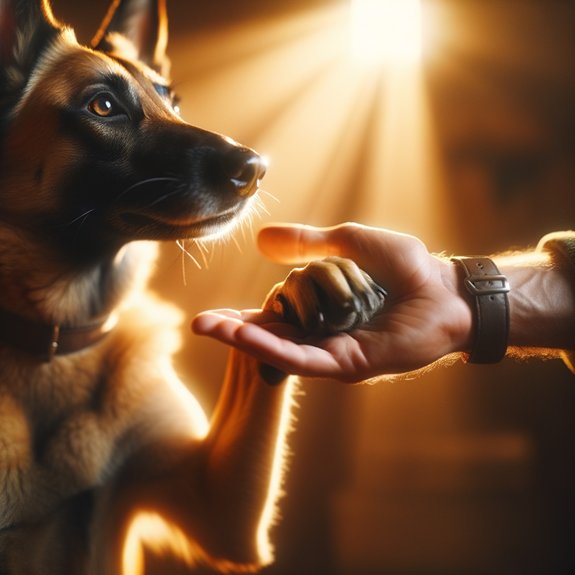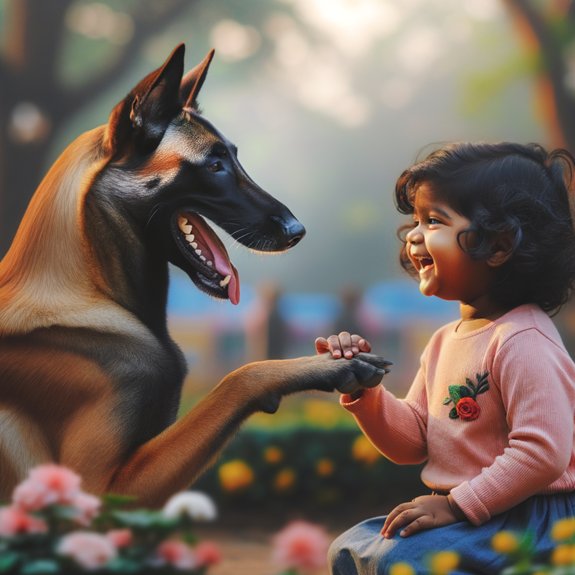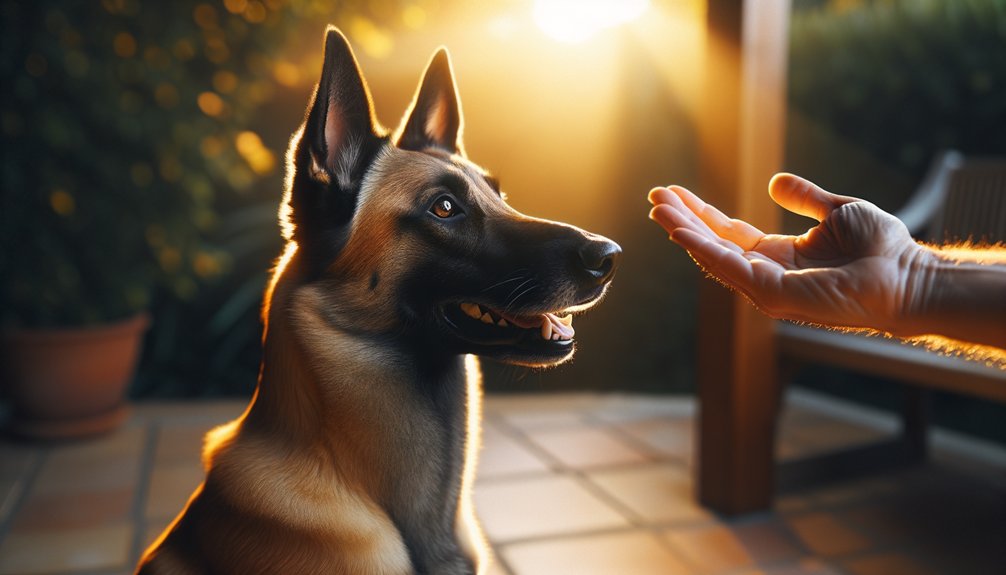AI-assisted
Last updated on May 23, 2025
Teaching a Belgian Malinois to shake hands serves multiple practical purposes. This simple trick not only fosters a deeper bond between the dog and owner but also enhances obedience and training skills, making it an effective method for reinforcing communication. Additionally, engaging in this activity provides mental stimulation, which is essential for such an intelligent breed. Furthermore, this skill can facilitate social interactions, promoting confidence in various environments. Understanding these benefits can lead to more effective training strategies. Discover the surprising benefits of teaching your Belgian Malinois to shake hands, and unlock a new level of communication and connection with your dog.
Key Takeaways
- Teaching your Belgian Malinois to shake hands enhances the bond between you and your dog through positive interaction and reinforcement.
- This trick promotes mental stimulation, keeping your Malinois engaged and alleviating boredom through fun and challenging activities.
- Learning to shake hands reinforces obedience and training skills, making your dog more responsive to commands and improving overall behavior.
- It provides an opportunity for social interaction, boosting your dog’s confidence in meeting new people and strengthening their adaptability.
- Teaching this trick creates joyful moments and lasting memories, enriching the relationship and fostering a sense of achievement for both you and your dog.
The Importance of Bonding With Your Belgian Malinois
Bonding with a Belgian Malinois is an important aspect of responsible dog ownership, as this process not only enhances the relationship between the dog and its owner but also contributes significantly to the dog’s overall behavior and well-being.
Engaging in bonding activities, such as playtime, interactive games, and outdoor adventures, fosters trust building, which is vital for developing a harmonious partnership. The Malinois, known for its intelligence and energy, thrives on mental and physical stimulation; therefore, incorporating varied activities into their routine allows for a deeper connection.
Engaging in play and outdoor adventures fosters trust and deepens the bond with your intelligent and energetic Belgian Malinois.
Trust building, achieved through consistent positive reinforcement and shared experiences, enables the dog to feel secure and valued, which can mitigate behavioral issues. Moreover, this strong bond may lead to improved communication, allowing the owner to better understand their dog’s needs and instincts.
Ultimately, prioritizing bonding will yield a more fulfilled and balanced canine companion, promoting a mutually beneficial relationship.
Enhancing Obedience and Training Skills

Enhancing obedience and training skills in a Belgian Malinois is essential for both the dog’s safety and the owner’s peace of mind, as this breed is known for its high intelligence and strong work ethic.
Effective obedience reinforcement strategies, such as consistent commands and positive reinforcement, guarantee that the dog understands expectations and responds promptly. This approach not only solidifies the bond between the dog and owner but also fosters a sense of security for both parties.
In addition, skill development through targeted exercises, such as teaching the dog to shake hands, can enhance the dog’s overall behavior and responsiveness.
By engaging in regular training sessions, the owner cultivates an environment conducive to learning, allowing the Belgian Malinois to thrive mentally and physically.
Ultimately, these training practices contribute to a well-adjusted dog capable of maneuvering various situations, thereby promoting harmony in the relationship between the owner and their canine companion.
Providing Mental Stimulation and Engagement

Mental stimulation is an essential component in the overall well-being of a Belgian Malinois, a breed renowned for its intelligence and energy. Engaging a Malinois in cognitive exercises not only alleviates boredom but also fosters mental agility and problem-solving skills.
Activities such as puzzle toys or scent games provide playful challenges that stimulate their sharp minds, allowing them to explore and engage with their environment in meaningful ways. In addition, teaching tricks, including the classic shake hands, serves as an effective method for reinforcing learning while keeping the dog mentally active.
These exercises promote a sense of achievement and can greatly enhance the bond between the dog and its owner. By incorporating regular mental challenges into a Malinois’s routine, owners facilitate a fulfilling lifestyle that caters to the breed’s innate need for engagement, ultimately contributing to their overall happiness and well-being.
Encouraging Social Interaction and Confidence
While social interaction is often overlooked, it plays a critical role in the development of confidence in Belgian Malinois dogs, a breed characterized by their high intelligence and strong work ethic. Engaging in social interactions not only fosters essential social skills but also facilitates confidence building in these dogs, enabling them to navigate various environments with poise.
To effectively encourage this interaction, owners can consider the following strategies:
- Regularly introduce new people and dogs to promote adaptability.
- Participate in group training classes to enhance social skills through structured activities.
- Arrange playdates with other dogs to build confidence in social settings.
- Utilize positive reinforcement to reward confident behavior during interactions.
- Expose the dog to diverse environments to acclimate them to different stimuli.
Creating Lasting Memories and Joyful Moments
Creating lasting memories and joyful moments with a Belgian Malinois not only enriches the bond between the dog and its owner but also serves as a foundation for the dog’s overall happiness and well-being.
Engaging in activities that promote interaction, such as teaching the dog to shake hands, can facilitate the creation of traditions that strengthen their relationship. These rituals, whether they involve simple playtime or more structured training sessions, offer opportunities for capturing moments that reflect the unique connection shared between the owner and the dog.
Each successful interaction not only enhances the dog’s confidence but also serves as a reminder of the joy derived from companionship. Through consistent practice and shared experiences, owners can cultivate an environment that fosters both learning and enjoyment, ultimately leading to a deeper understanding of their Belgian Malinois and a lifetime of cherished memories.
Frequently Asked Questions
How Long Does It Take to Teach a Belgian Malinois to Shake Hands?
The training duration for a Belgian Malinois to learn to shake hands varies, influenced by the dog’s learning pace and prior training experiences. Typically, consistent practice can yield results within a few sessions, fostering a joyful bonding experience.
What Treats Work Best for Training My Belgian Malinois?
A trainer found that using high value rewards, like small pieces of chicken, substantially boosted training motivation in their Belgian Malinois. This reinforced positive behavior, resulting in quicker learning and a deeper bond between dog and owner.
Can All Breeds Learn to Shake Hands Like a Belgian Malinois?
All dog breeds can learn to shake hands, though breed differences may affect training ease. With patience and consistent dog training techniques, any dog, regardless of breed, can master this charming trick, fostering a sense of freedom.
What Age Is Best to Start Teaching This Trick?
The ideal age to start teaching this trick is during the puppy readiness stage, typically around six to eight weeks. Early training fosters a sense of freedom and encourages bonding, enhancing the learning experience for both dog and owner.
Are There Any Safety Concerns While Teaching This Behavior?
Teaching a dog to shake hands requires careful consideration of safety precautions to mitigate potential risks. Ensuring a calm environment and using positive reinforcement can foster a safe learning experience, promoting both fun and confidence in the dog.



